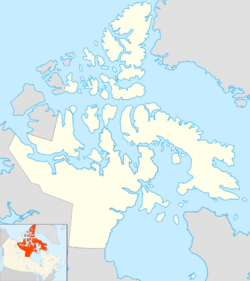Bear Island (Nunavut) facts for kids
| Geography | |
|---|---|
| Location | Frobisher Bay |
| Coordinates | 62°27′N 64°17′W / 62.450°N 64.283°W |
| Archipelago | Canadian Arctic Archipelago |
| Administration | |
|
Canada
|
|
| Territory | Nunavut |
| Region | Qikiqtaaluk |
| Demographics | |
| Population | Uninhabited |
Bear Island is a small, uninhabited island located off the coast of Baffin Island in Nunavut, Canada. It sits in the Labrador Sea, very close to where it meets Frobisher Bay. This island is part of a group of many islands found in this northern part of Canada.
Contents
Exploring Bear Island's Location
Bear Island is found in the Qikiqtaaluk Region of Nunavut. This region is a vast area in Canada's far north. The island's exact spot is a few kilometers north of Frobisher Bay. Frobisher Bay is a large inlet of the Labrador Sea.
Nearby Islands and Geography
Bear Island is not alone in this part of the Canadian Arctic Archipelago. It has several neighbors. These include the Harper Islands, Lefferts Island, and Little Hall Island. Another nearby island is Hudson Island. All these islands are near the tip of a landmass called Hall Peninsula.
What is an Uninhabited Island?
An uninhabited island means that no people live there permanently. Bear Island is a wild place. It is home to animals and plants adapted to the Arctic environment. These islands are often important for wildlife. They provide safe places for birds to nest. They also offer habitats for marine mammals.
Nature and Wildlife of the Arctic
Even though Bear Island is small, it is part of a huge ecosystem. The Arctic is known for its unique wildlife. Animals like polar bears, seals, and various seabirds live here. The waters around Bear Island are very cold. They are rich in marine life.
Arctic Climate and Environment
The climate around Bear Island is very cold for most of the year. Winters are long and dark. Summers are short and cool. The land is often covered in snow and ice. This harsh environment shapes the types of plants and animals that can survive there. Only tough, specialized species thrive in this region.



